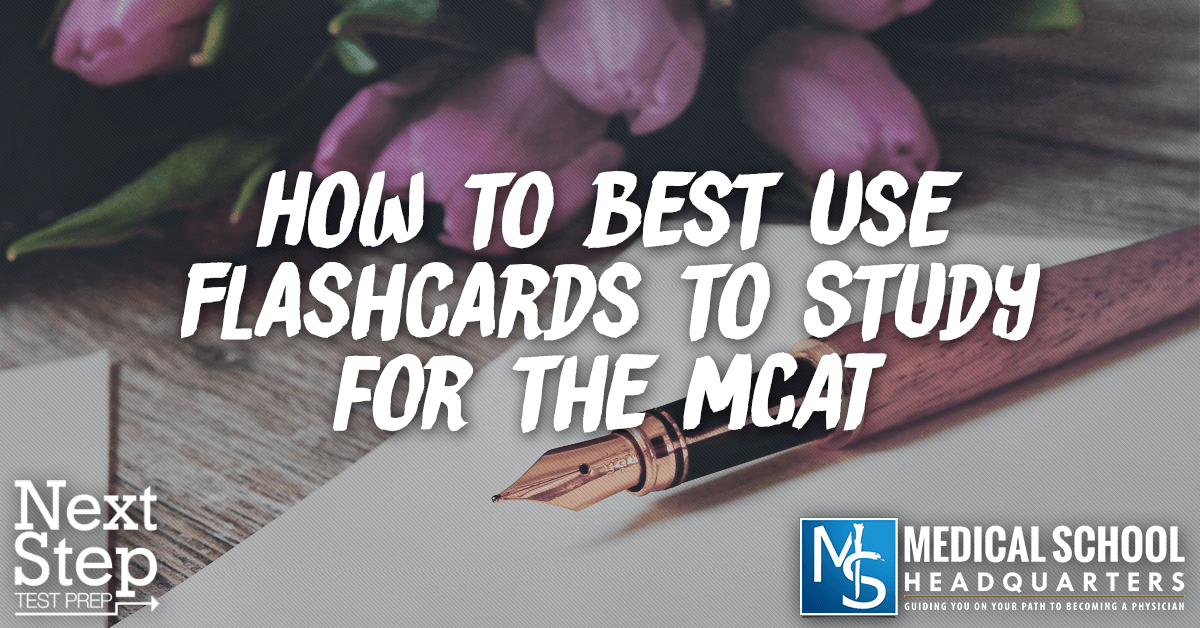You still have time to sign up with one of our amazing expert advisors! Learn More!

Flashcards are a great tool to utilize as a premed. Whether you’re using Anki, Quizlet, Brainscape, or your own handwritten flashcards, they can be a very effective study method.
Today, I chat with Bryan from Blueprint MCAT (formerly Next Step Test Prep) about how to use flashcards for the MCAT to maximize your study time!
Flashcards are one of the most popular study tools out there. There are many different options, and the first (and biggest) consideration is whether you should buy them or make them.
Bryan says he’s contractually required as a teacher to say it’s always better to make your own. The act of making your own flashcards really helps solidify the information on them. Sometimes just the act of making them helps you learn the material better than any result you can get with flashcards you buy.
The act of making your own flashcards really helps solidify the information on them.Click To TweetThe AAMC sells flashcards. For $10, you can buy flashcards direct from the AAMC. But you want to be real clear about what the product is.
The fact it’s an official AAMC prep product means a lot of people are just going to buy it without checking it out first. But the AAMC flashcards are just little 3 x 5 cards. A science discrete question is printed on one side, and the answer is printed on the other side.
If what you want is a hundred fifty discrete science questions, go ahead and buy the card deck. But spending $10 for a hundred fifty discrete science questions, Bryan says, is a pretty bad deal. For $30, you can get 2,000 science questions from something like the Next Step MCAT QBook.
So, Bryan warns you not to be fooled into expecting the AAMC flashcards to be anything remarkable. You can also go to one of the big publishing companies like the Barron’s MCAT Flashcards you can pick up at Barnes and Noble. However, Bryan doesn’t recommend them.
For most students nowadays, flashcards you can have on your phone are much better. But if you have an old-fashioned study style, then the print flashcards from Barron’s are totally fine.
When you think about how people study with flashcards, they’re meant for learning, drilling, and repeating content. For example, one side says “List all the hormones secreted by the anterior pituitary,” and then the other side of the flashcard lists the answers. It’s about drilling science facts, not practicing questions, passages, and strategies.
So, it struck Bryan as really weird when the AAMC says they’re offering flash cards. He was totally psyched. Then what we got is this weird little collection of practice problems. But that’s what you use an online question bank for.
Bryan prefers digital flashcards because they can use spaced repetition as a learning technique. What a good flashcard app will do is provide you with a spaced repetition algorithm. The underlying idea is if it’s something you’re good at, you should repeat it very rarely. And if it’s something you’re bad at or you’re still trying to master, you should repeat it more frequently.
Bryan prefers digital flashcards because they can use spaced repetition as a learning technique.Click To TweetBrainscape is the company that Blueprint MCAT (formerly Next Step Test Prep) partners with. They have an app that will show you your MCAT flashcards. Then as you answer each question on each flashcard, you push a little button in half a second. Rate it from one to five. Five is where you perfectly know the card, and one is you’ve gotten it completely wrong.
As you cycle through the cards, Brainscape is smart enough to show you any card you rated one, two, or three more frequently. Then the threes and fours are shown less frequently, and the fives even less often. So if you just sit down and keep working with these flashcards until you’ve turned all of them from ones to threes, and then to fives, then you really know you’ve mastered the content.
Another hugely popular option is the Anki App, a flashcard display algorithm. It doesn’t provide you with the completed flashcards itself. You can download Anki and make your own flashcards—which is the best—or they have this built-in function to share decks of flashcards with each other.
You can look around online and find someone else’s Anki deck of MCAT flashcards. But be careful since you’re relying on the quality created by other users. It’s a free app to use on your computer, but you have the option to upgrade to the premium version if you like, and then you can use it on your phone, too.
If you’re thinking of being premed, then start using a flashcard app to study as early as freshman year. This makes sure all of the content you’re learning just doesn’t just disappear out of your head the second you take your exam. Because then when you get around to taking the MCAT, much more of it will still be in your head.
Bryan recalls being in his second year of college. He was taking a class, and the professor asked a question. Bryan remembers raising his hand and bringing up something from the previous semester. The professor was shocked since he never had a student bring up something from last semester’s class before.
It’s depressing everyone just immediately forgets everything after their final exams. Unfortunately, this really hurts you when the MCAT rolls around. So the sooner you can start learning on a permanent basis, the better.
The sooner you can start learning on a permanent basis, the better.Click To Tweet
Lorem ipsum dolor sit amet, consectetur adipiscing elit
I just received my admission to XXXXX! This is unreal and almost feels like I am dreaming. I want to thank you for all of your help with my application. I cannot overstate how influential your guidance and insight have been with this result and I am eternally grateful for your support!
IM SO HAPPY!!!! THANK YOU SO MUCH FOR ALL YOUR HELP, IM INDEBTED TO YOU! Truly, thank you so much for all your help. Thank you doesnt do enough.
I want to take a few moments and thank you for all of your very instructive, kind and consistent feedback and support through my applications and it is your wishes, feedback, and most importantly your blessings that have landed me the acceptance!
I got into XXXXX this morning!!!! It still has not hit me that I will be a doctor now!! Thank you for all your help, your words and motivation have brought me to this point.
I wanted to once again express my heartfelt gratitude for your help in providing feedback during my secondary applications. Your guidance has been instrumental in my journey.
Just wanted to share my wonderful news! I received my first medical school acceptance! Thank you for all that you do for us Application Academy!!!
I am excited to tell you that I just got my third interview invite from XXXXX today! I can’t believe it. I didn’t even know if I was good enough to get one, let alone three – by mid-September. Thank you so much for all of your help and support up to this point; I would not be in this position without it!!
I wanted to thank you for helping me prepare for my XXXXX interview. Even in a 30-minute advising session, I learned so much from you. Thank you for believing in me, and here’s to another potential success story from one of your advisees!
I just received an acceptance with XXXXX! This is so exciting and such a huge relief and so nice to have one of our top choice schools! I also received an interview with XXXXX which brings the total up to 20 interviews! Thank so much, none of this would have been possible without you!

Join our newsletter to stay up to date
* By subscribing you agree to with our Privacy Policy and provide consent to receive updates from our company.
Resources
Advising Services
Podcasts & Youtube
Books
About
Deal Lasts for

"*" indicates required fields